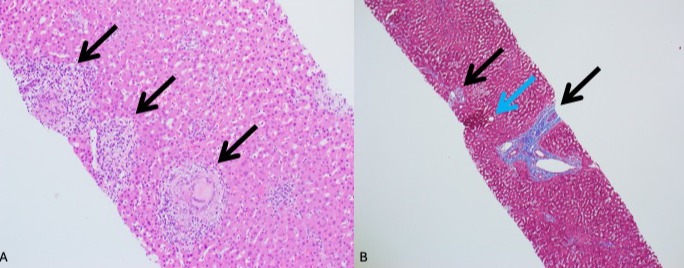Tuesday Poster Session
Category: Liver
P4711 - An Unanticipated and Painful Diagnosis: Symptomatic Hepatic Sarcoidosis
Tuesday, October 29, 2024
10:30 AM - 4:00 PM ET
Location: Exhibit Hall E

Has Audio
- SE
Samuel Engman, DO
University of Chicago Endeavor Health
Evanston, IL
Presenting Author(s)
Samuel Engman, DO, Raza Muhammad, DO, Maryam Haider, MD, Ian Clark, MD, Blake Jones, MD
University of Chicago Endeavor Health, Evanston, IL
Introduction: Sarcoidosis is a systemic granulomatous disorder caused by the activation of T-lymphocytes and macrophages. It manifests in the pulmonary system as bilateral hilar lymphadenopathy. Extra-pulmonary sarcoidosis occurs in 30% of patients, of which 50%-65% develop hepatic sarcoidosis. Of this population, 85%-95% are asymptomatic or minimally symptomatic. When symptomatic, patients may complain of abdominal pain, pruritis and jaundice.
Case Description/Methods: A 38 year old male with past medical history of IgA nephropathy, GI bleeding and GERD presented with severe right upper quadrant and epigastric abdominal pain beginning 23 days earlier. It was described as burning in quality and associated with nausea, decreased appetite and weight loss. He was noted to have an ALP of 157, otherwise his remaining hepatic panel and CBC were negative. A CT abdomen and pelvis was notable for splenomegaly. During a recent admission for similar symptoms, AMA, ASMA, CMV IgM and a hepatitis panel were negative. EBV IgG and EBNA were positive. MRCP noted a distended gallbladder, and HIDA scan showed nonspecific delayed filling and moderate to severe duodenogastric bile reflux. Cholecystitis was ruled out. EGD noted LA Grade B reflux esophagitis and some erythematous gastric mucosa negative for helicobacter pylori. A liver biopsy was performed which revealed noncaseating granulomas. An angiotensin converting enzyme (ACE) was negative. He had a recent and extensive workup for lung nodules including biopsy and wedge resection. He was initially diagnosed with MAC however did not tolerate treatment. MAC culture and PCR were negative. He was diagnosed with hepatic and pulmonary sarcoidosis, and started on mycophenolate mofetil.
Discussion: This is a unique case of hepatic sarcoid in that the patient presented with abdominal pain, which only occurs in at most 15% of patients. He demonstrated elevation of his ALP consistent with the infiltrative and cholestatic nature of hepatic sarcoidosis. ACE was negative. This enzyme is produced by activated macrophages seen in sarcoidosis and other granulomatous diseases. However, due to its poor sensitivity, specificity, positive and negative predictive values, a negative result does not rule out sarcoidosis. The finding of noncaseating granulomatous inflammation in the liver in conjunction with his prior pulmonary history helped elucidate the diagnosis. This illustrates the importance of the gastroenterologist to recognize all presentations of hepatic sarcoid.

Disclosures:
Samuel Engman, DO, Raza Muhammad, DO, Maryam Haider, MD, Ian Clark, MD, Blake Jones, MD. P4711 - An Unanticipated and Painful Diagnosis: Symptomatic Hepatic Sarcoidosis, ACG 2024 Annual Scientific Meeting Abstracts. Philadelphia, PA: American College of Gastroenterology.
University of Chicago Endeavor Health, Evanston, IL
Introduction: Sarcoidosis is a systemic granulomatous disorder caused by the activation of T-lymphocytes and macrophages. It manifests in the pulmonary system as bilateral hilar lymphadenopathy. Extra-pulmonary sarcoidosis occurs in 30% of patients, of which 50%-65% develop hepatic sarcoidosis. Of this population, 85%-95% are asymptomatic or minimally symptomatic. When symptomatic, patients may complain of abdominal pain, pruritis and jaundice.
Case Description/Methods: A 38 year old male with past medical history of IgA nephropathy, GI bleeding and GERD presented with severe right upper quadrant and epigastric abdominal pain beginning 23 days earlier. It was described as burning in quality and associated with nausea, decreased appetite and weight loss. He was noted to have an ALP of 157, otherwise his remaining hepatic panel and CBC were negative. A CT abdomen and pelvis was notable for splenomegaly. During a recent admission for similar symptoms, AMA, ASMA, CMV IgM and a hepatitis panel were negative. EBV IgG and EBNA were positive. MRCP noted a distended gallbladder, and HIDA scan showed nonspecific delayed filling and moderate to severe duodenogastric bile reflux. Cholecystitis was ruled out. EGD noted LA Grade B reflux esophagitis and some erythematous gastric mucosa negative for helicobacter pylori. A liver biopsy was performed which revealed noncaseating granulomas. An angiotensin converting enzyme (ACE) was negative. He had a recent and extensive workup for lung nodules including biopsy and wedge resection. He was initially diagnosed with MAC however did not tolerate treatment. MAC culture and PCR were negative. He was diagnosed with hepatic and pulmonary sarcoidosis, and started on mycophenolate mofetil.
Discussion: This is a unique case of hepatic sarcoid in that the patient presented with abdominal pain, which only occurs in at most 15% of patients. He demonstrated elevation of his ALP consistent with the infiltrative and cholestatic nature of hepatic sarcoidosis. ACE was negative. This enzyme is produced by activated macrophages seen in sarcoidosis and other granulomatous diseases. However, due to its poor sensitivity, specificity, positive and negative predictive values, a negative result does not rule out sarcoidosis. The finding of noncaseating granulomatous inflammation in the liver in conjunction with his prior pulmonary history helped elucidate the diagnosis. This illustrates the importance of the gastroenterologist to recognize all presentations of hepatic sarcoid.

Figure: Hepatic Sarcoidosis. A: H and E stain of liver parenchyma. Black arrows point to non-caseating granulomas. B: Trichrome stain of liver parenchyma. Black arrows point to portal triads. Blue arrow points to central vein.
Disclosures:
Samuel Engman indicated no relevant financial relationships.
Raza Muhammad indicated no relevant financial relationships.
Maryam Haider indicated no relevant financial relationships.
Ian Clark indicated no relevant financial relationships.
Blake Jones indicated no relevant financial relationships.
Samuel Engman, DO, Raza Muhammad, DO, Maryam Haider, MD, Ian Clark, MD, Blake Jones, MD. P4711 - An Unanticipated and Painful Diagnosis: Symptomatic Hepatic Sarcoidosis, ACG 2024 Annual Scientific Meeting Abstracts. Philadelphia, PA: American College of Gastroenterology.
